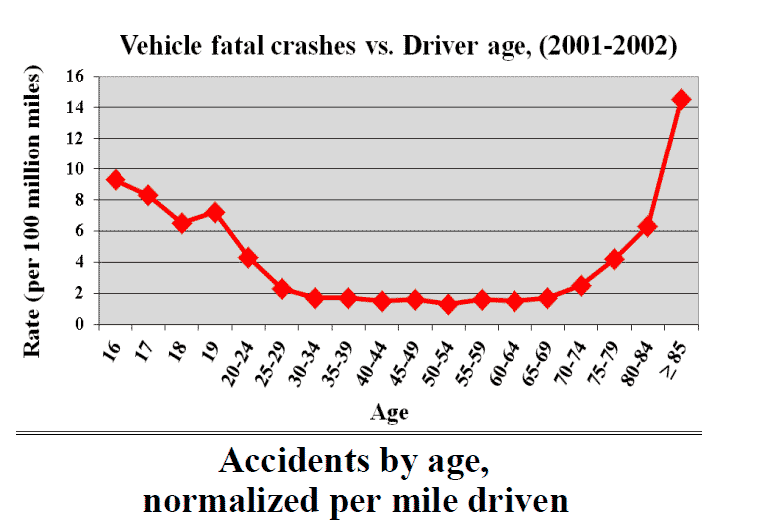According to The American Occupational Therapy Association and several state DMV’s, there are many myth’s about older drivers, many of which have little or no supporting evidence for, which include:
Myth #1: Currently, there are age limitations on driver licenses in several states
FALSE: There are no states with laws limiting upper-limits on drivers ages. As long as an adult can continue to pass the required driving tests, which are often only in written form, they can continue to drive. States such as New York, Oregon, Virginia, Wisconsin, Delaware, Maryland, and Mississippi have the maximum renewal lengths of 8 years, regardless of age. Rhode Island has the shortest renewal period for adults over 75 at a mere 2 years. Other states have changing requirements, often based on age, and may require everything from vision tests to physician exams.
Myth #2: Seniors cause more accidents than younger drivers:
PARTLY FALSE: However, drivers above 75 in age are more likely to die as their bodies are more fragile than younger drivers, making it more difficult to withstand the impact of a collision.

Additionally, other studies, such as one by the University Transportation Research Center, suggest that the accident rate actually begin to substantially increase at 70 years of age after normalized for per-mile driven.
Of course, if older adults drive less total mileage, this can still mean a total reduction in accidents over the same period of time. Other factors may still be unknown such as driving area.
Myth #3: Most older drivers do not stop driving after their ability to drive decreases.
FALSE: While some drivers do monitor and regulate their own behavior, others do not .There are no studies indicating that older drivers do not cease driving with age. While certain changes such as impaired vision can create obvious choices for drivers to reduce driving time, cognitive functions may not, partly because they can reduce the judgment and decision-making abilities. In such cases, road test or other testing may be useful in determining a drivers actual ability.
Myth #4: Aging inevitably causes all older adults to deteriorate in driving ability.
FALSE: While physical health such as vision, hearing, strength, and reaction time decline as people age, each person’s ability changes at a different rate. Some 90-year olds may be as healthy and responsive as drivers half their age (which are among the safest on the road statistically).
Myth #5: Most physicians are familiar with aging issues as they affect older drivers.
FALSE: Physicians routinely refer older drivers to DMV’s for further investigation since the complexity of aging as it pertains to driving is beyond the scope of their regular care. Other physicians prefer not to get involved in day-to-day decisions of their patients, partly because it may not be their business, and partly because of the risk of legal action, or losing a patient as honesty among doctors is a common issue today. However, the trade-off exists that if a doctor does not act, then they may be contributing to the future jeapordy of their patient and others on the road.
Myth #6: The DMV can recognize and prohibit less capable drivers when they come into the DMV office.
FALSE: Not only are many tests online now, but no states have training nor systems in place for recognizing and limiting high risk drivers who simply walk into their offices. Considering that DMV renewals can occur every 10+ years, this also contributes to the issue. Considering that most tests are written, this is another reason high risk drivers cannot be identified. In the uncommon cases where the person is required to take a road test, such tests can easily miss warning signs, and issues that may not appear during a short test.
Myth #7: Increasing the road to better accommodate older drivers would be unaffordable or prohibitively expensive.
FALSE: Many road improvements require little to no additional cost to make them safer, yet these new or re-construction designs need to incorporate the safety elements in during the planning phases. Roads that are safer for older drivers are roads that are safer for everyone including pedestrians.
Myth #8: Public transportation is a convenient and common alternative for adults who no longer drive.
FALSE: The first problem is the lack of public transportation, which is limited mainly to denser urban areas, not only in having the transportation, but having enough routes to accommodate where most people need to go. Additionally, many older drivers have physical (e.g. disability) or mentally at risk (e.g. poor memory) for public transportation. However, public transportation accessibility generally has increased over time.
Next in this series: Identifying & Managing Older Driver Health Risks
Return to main page: Senior Driving Safety